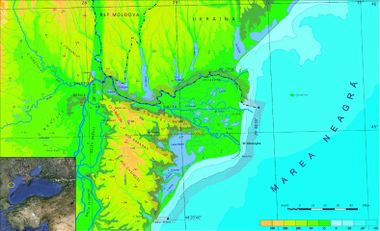Difference between revisions of "Danube Delta"
| Line 15: | Line 15: | ||
<u>'''Main coastal issues'''</u> | <u>'''Main coastal issues'''</u> | ||
| − | - Habitat degradation | + | - Habitat (anthropic and natural)degradation |
- Loss of biodiversity | - Loss of biodiversity | ||
| − | - | + | - Global Changes impacts on population livelihood and wellbeing |
| − | - | + | - Coastal/Sea Spatial Planning |
| + | |||
| + | <u>'''Relation between the Coastal issue and the ICZM protocol principles and articles'''</u> | ||
| + | |||
| + | Article 7: avoid compartmentalization of coastal zone management between agencies and organise an integrated plan. For example recently a law was passed to define the specific coastal areas for aquaculture development when the national plan for coastal zone management is still under preparation by the Ministry of Environment and Climatic Change. | ||
| + | |||
| + | Article 8: the uncontrolled urbanization triggered by tourist development and the concentration of population in small areas is negative for the coastal environment (§8.1) and some actions to delimit areas should be taken (§8.3). | ||
| + | |||
| + | Article 9: all issues are direct economic activities and therefore their development needs to be balanced for benefits for BOTH the sectors and the environment (§9.1.a,b,f) while promoting best practice approaches (§9.2. all). | ||
| + | |||
| + | Article 10: Urbanisation and un-controlled tourist infrastructure building (temporary and permanent) may cause negative effects on specific ecosystems (for the CASE: §10.2, 10.4). The same applies also for article 11 about landscapes. | ||
| + | |||
| + | Article 12: as a whole since it refers to Islands | ||
| + | |||
| + | Article 14: limited basis since voluntary participation is non-existent. | ||
| + | |||
| + | |||
| + | <u>'''Relevance of the coastal issue'''</u> | ||
| + | |||
| + | Black Sea as a big hydrographic basin and unique ecosystem is extremely sensitive exposed to serious threats as pollution, habitats degradation, biodiversity decline, overexploitation of resources, coastal erosion, etc. Thus, within this activity were identified main regional indicators: physic-chemical indicators, indicators for marine living resources and general coastal zone impact indicators (population, land use, agriculture, tourism, coastal erosion). | ||
| Line 50: | Line 69: | ||
| − | <u>''' | + | <u>'''PEGASO tools developed and used'''</u> |
Indicators - LEAC - Scenarios - Participatory methods. | Indicators - LEAC - Scenarios - Participatory methods. | ||
| − | |||
| − | |||
Revision as of 15:15, 19 July 2012
CASE description
The coast of Danube Delta (Romania) comprised between Musura branch and Midia cape in South (166 km) is characterized by sandy beaches and low altitudes less steep underwater slopes.
ICZM phase
Main coastal issues
- Habitat (anthropic and natural)degradation
- Loss of biodiversity
- Global Changes impacts on population livelihood and wellbeing
- Coastal/Sea Spatial Planning
Relation between the Coastal issue and the ICZM protocol principles and articles
Article 7: avoid compartmentalization of coastal zone management between agencies and organise an integrated plan. For example recently a law was passed to define the specific coastal areas for aquaculture development when the national plan for coastal zone management is still under preparation by the Ministry of Environment and Climatic Change.
Article 8: the uncontrolled urbanization triggered by tourist development and the concentration of population in small areas is negative for the coastal environment (§8.1) and some actions to delimit areas should be taken (§8.3).
Article 9: all issues are direct economic activities and therefore their development needs to be balanced for benefits for BOTH the sectors and the environment (§9.1.a,b,f) while promoting best practice approaches (§9.2. all).
Article 10: Urbanisation and un-controlled tourist infrastructure building (temporary and permanent) may cause negative effects on specific ecosystems (for the CASE: §10.2, 10.4). The same applies also for article 11 about landscapes.
Article 12: as a whole since it refers to Islands
Article 14: limited basis since voluntary participation is non-existent.
Relevance of the coastal issue
Black Sea as a big hydrographic basin and unique ecosystem is extremely sensitive exposed to serious threats as pollution, habitats degradation, biodiversity decline, overexploitation of resources, coastal erosion, etc. Thus, within this activity were identified main regional indicators: physic-chemical indicators, indicators for marine living resources and general coastal zone impact indicators (population, land use, agriculture, tourism, coastal erosion).
Objectives
- Improvement of coastal ecosystem knowledge
- Biodiversity conservation
- Regulation of economical activities on ecological bases
- Protection and rehabilitation of habitats and ecosystems
End Products
- Creation of a database for ICZM
- Development of thematic maps
- Organisational design in the field of maritime spatial planning
- Elaboration of a preliminary ICZM strategy
- Project proposal for new funding
PEGASO tools developed and used
Indicators - LEAC - Scenarios - Participatory methods.
Other tools to be applied
SketchMetch method (Spatial planning tool)
Training needs
LEAC - Scenarios
CASE Responsible
Iulian Nichersu - Danube Delta national Institute for Research and Development, Tulcea - email: iuli@indd.tim.ro
Elaboration: Stefano Soriani, Fabrizia Buono, Monica Camuffo, Marco Tonino, University Ca’ Foscari of Venice.


